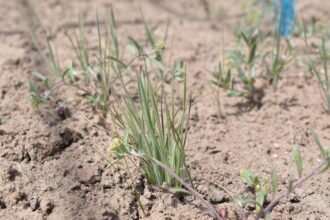Massive wildfires are on the rise throughout the West, reshaping plant communities and endangering native grasses that are a key source of forage for livestock. Reseeding with locally sourced seed is a common rangeland restoration strategy, but climate change raises an interesting question: What’s the best way to heal the land when its future environment might not look like its past?
“Maybe we also need to look to climates that may be more in keeping with what future conditions might bring,” said Lina Aoyama, Ph.D. candidate from the University of Oregon. Funded by a grant from the Western Sustainable Agriculture and Education program, Aoyama is exploring ways to improve post-fire reseeding efforts and promote resilient rangelands in the Great Basin, which includes most of Nevada, half of Utah and sections of Idaho, Wyoming, Oregon and California.
Land managers in the Great Basin usually reseed burned rangeland with native grasses that grew in the area before the fire, which is generally what land restoration is all about. Aoyama wondered how native-grass cultivars bred in different environments would compare with local seeds when grown under simulated drought conditions.
To evaluate performance, Aoyama grew locally sourced seeds alongside native-grass seeds from two other climates, one that was hotter and drier and another that was cooler and wetter. She grew the seeds in three controlled environments: One with ambient rainfall, one under moderate drought conditions and another under severe drought conditions.
Under moderate drought conditions, which forecasters predict will occur more frequently in the Great Basin, seeds from drier and hotter regions and from cooler, wetter regions performed better than the locally sourced seeds.
“The seeds employed different strategies, but they both out-performed the local native-grass seeds in moderate drought conditions,” Aoyama said.
Under severe drought conditions, virtually none of the samples performed well.
Aoyama’s takeaway: Variety gives post-fire seeding the best chance to succeed.
“It’s good to hedge your bet,” she explained. “Seeds from various climates provide greater genetic diversity and more strategies to adapt when faced with stressful growing conditions.”
In the short run, it won’t be easy for land managers to buy large quantities of native-grass seeds from multiple climates. Aoyama hopes that, in the future, projects like these can help expand seed availability and support evolving restoration strategies.
Rangeland restoration is at the heart of several other SARE projects. One multi-disciplinary team in Central Idaho is looking for ways to control cheatgrass and other invasive grasses, which are as destructive as fire to Western rangeland. The team of university researchers, U.S. Forest Service experts and sheep producers are testing whether grazing sheep in rangeland can keep the invasive weeds in check.
The goal, as with Aoyama’s project, is to keep rangelands economically and environmental sound.
“We hope to help safeguard viability and quality of life for ranchers and rangeland now and into the future,” she said.
